Starting a smoke shop or a dispensary is exciting. I’ve helped many wholesalers succeed by choosing the right fixtures. Let’s break it down step by step. Learn how to go about starting a smoke shop or a dispensary with smart planning, budgeting, and store fixture setup.
Table of Contents
ToggleResearching Laws Before Starting


Opening a smoke shop or a dispensary takes more than passion and capital. Legal groundwork plays a vital role. Getting it wrong can lead to serious setbacks. Researching laws before starting a smoke shop or a dispensary is a non-negotiable step. The legal side defines what, how, and where you can sell. It affects your product range, your marketing, and your long-term success. Let’s dive into what matters.
Understanding Federal, State, and Local Law Differences
Legal systems vary across levels of government. Starting a smoke shop or a dispensary means aligning your operations with multiple layers of regulation. Federal laws may clash with state-level permissions, especially in the case of dispensaries. While smoke products such as hookahs or vapes might face fewer hurdles, dispensary items often remain illegal at the federal level in some countries. Even in regions where cannabis is legal for recreational or medical use, the laws change quickly.
State authorities often regulate licensing, taxation, and compliance matters. For instance, opening a dispensary in California requires going through the Department of Cannabis Control. In contrast, a smoke shop in Texas may fall under tobacco or alternative product categories. These nuances affect how you register your business, what taxes apply, and how your shop is inspected.
Local ordinances add a third layer of complexity. City councils or counties may restrict where stores can open. Zoning regulations may keep smoke shops away from schools or residential areas. Noise ordinances, parking space requirements, and signage rules can further restrict business operations. Some towns may allow smoke shops but ban dispensaries completely. Others may impose strict operational hours or prohibit in-store sampling.
Failing to research local policies can stall your opening or result in legal fines. Speaking with local officials early prevents surprises. Seeking out official documentation ensures accuracy. Laws also update frequently. Regularly reviewing legal notices or subscribing to government bulletins helps stay compliant.
Understanding these layers helps you align your business plan with the law. Without this knowledge, even a strong retail concept could collapse. It’s not just about being legally sound—it’s about building a solid foundation that protects your investment.
Acquiring Required Licenses and Permits
Licensing processes vary by location and shop type. Starting a smoke shop or a dispensary without the right permits will result in penalties. Most areas require a basic business license, a resale permit, and industry-specific credentials. Some licenses only apply to stores selling tobacco, CBD, or nicotine products. Others involve special permissions for THC-based goods, which fall under tighter scrutiny.
Typically, a seller’s permit is required to collect sales tax. This is crucial for any store selling physical goods. Depending on what you plan to stock, you may need a tobacco retailer’s license or even a controlled substances permit. Fire safety certificates, health department clearances, and zoning approvals often go hand in hand with retail licensing.
For dispensaries, expect to complete more applications. Product testing, inventory tracking, and even employee training might be part of the requirement. In some jurisdictions, only a limited number of dispensary licenses are issued annually. That makes early planning and timely submission crucial. Missing a deadline could delay your launch for a full year or longer.
Documents usually needed include business registration, ID copies, proof of lease, floor plans, and financial statements. Preparing these early speeds up approval. Visiting your local regulatory office or checking their website helps gather accurate checklists. Consulting with a legal advisor ensures you don’t miss key documents.
Permit renewals must be tracked. Many licenses are valid for one year and require timely renewal to stay compliant. Losing a license due to missed deadlines can force temporary closure. Automation tools or calendars help monitor expiration dates. Building compliance into your routine operations creates long-term stability.
Evaluating Zoning and Location Restrictions
Zoning laws determine where your business can legally operate. Researching laws before starting a smoke shop or a dispensary means knowing where your business is welcome—and where it’s not. Zoning regulations protect community interests and maintain balanced land use. They define which businesses can open in residential, commercial, or industrial zones.
Most cities limit smoke shops and dispensaries to specific areas. These locations are usually commercial strips or designated business districts. Dispensaries may have more zoning restrictions than smoke shops. They are often banned near schools, parks, churches, and residential blocks. Minimum distance rules apply—often requiring at least 500 feet between dispensaries and sensitive areas.
Checking zoning maps helps avoid location mistakes. Many local governments offer online zoning tools. By typing in an address, you can confirm if it’s eligible for your store type. You can also check neighboring property uses to avoid future disputes. A great retail location could be worthless if it’s zoned for residential use or lacks proper classification.
Some jurisdictions allow conditional use permits. These let you open in restricted zones by proving you meet extra conditions. These might include extra security, adjusted hours, or noise control measures. The application process involves hearings and community feedback. Success depends on strong community engagement and detailed planning.
Parking, signage, and building codes often accompany zoning requirements. For example, your store may need a minimum number of parking spots based on floor space. Signage laws may limit lighting, size, or promotional language. Ignoring these small details could lead to costly redesigns.
Navigating Product Regulations and Compliance Rules
Product laws define what you can stock, how you can sell it, and how you must label it. Starting a smoke shop or a dispensary means knowing exactly what’s allowed on your shelves. For smoke shops, the product range often includes glass pipes, hookahs, rolling papers, vaporizers, and accessories. Each item may fall under different regulations.
Some areas ban flavored tobacco or nicotine pouches. Others limit the sale of high-nicotine products. Packaging laws may require warning labels in specific fonts and colors. Selling non-compliant products could lead to fines or seizure of goods. Keeping track of these rules prevents legal trouble and protects your investment.
For dispensaries, product compliance becomes even more detailed. THC levels, childproof packaging, batch testing, and expiration labeling may be required. Barcode systems must track every product from supplier to sale. Some areas mandate the use of seed-to-sale software, which ensures transparency in cannabis distribution.
Lab testing is also key. Products must be tested for pesticides, molds, and potency. Certificates of analysis must be available for each batch. Stores that fail to present this documentation risk license suspension. Working with verified suppliers ensures that products meet all safety and labeling standards.
Marketing rules apply to products too. Advertising cannabis items may be banned in some media channels. In-store promotions might be limited to loyalty programs rather than public campaigns. Displaying certain items near the entrance may also be restricted.
Age verification rules vary. Most areas require customers to be over 21 to purchase tobacco or cannabis-related products. Store staff must check IDs at every purchase. Training staff on compliance builds trust and avoids penalties. Some areas perform random compliance checks, where mystery shoppers test your procedures.
How to Go with a Business Plan
Creating a business plan is a critical step in learning how to go about starting a smoke shop or a dispensary. This document sets the tone for everything that follows. A good plan defines your goals, outlines your strategy, and helps secure funding. It keeps you focused and aligned with your long-term vision. Investors and partners often ask to see your plan before they get involved. Let’s look at the key areas that make a solid business plan for this industry.
Identifying Your Vision and Target Market
Every successful business starts with a clear vision. This vision explains what your smoke shop or dispensary stands for. It defines the store’s purpose, its values, and the experience it aims to deliver. In this industry, the right vision helps you stand out from competitors. Maybe you want a luxury hookah experience. Maybe you’re focused on affordability and accessibility. Whatever your niche, your business plan should explain it.
Understanding the target market is just as important. A shop designed for tourists may look very different from one built for loyal local customers. Do your ideal buyers care more about high-end products or budget-friendly basics? Are they young adults, working professionals, or seniors seeking relief through medical cannabis? These questions shape your store’s design, product range, and pricing strategy.
To find answers, analyze demographics, foot traffic, and customer behavior. Use surveys, online research, and even interviews with existing store owners. The more data you gather, the better your positioning will be. When you know who you serve, you can tailor every part of the store to their needs. This builds a loyal customer base and boosts repeat business from day one.
Forecasting Start-Up Costs and Revenue Streams
Financial forecasting is one of the most vital parts of a business plan. It helps you understand how much money you need and how quickly you can recover it. Smoke shops and dispensaries both come with unique cost structures. Initial expenses include rent, legal fees, permits, inventory, fixtures, staff wages, and marketing. Store fixtures, like glass showcases and checkout counters, may also require custom fabrication and shipping.
A good plan includes detailed cost estimates. List everything—down to the smallest items. That way, you avoid hidden expenses later. Factor in Fairwill Display’s affordable prices for display fixtures to keep costs reasonable without sacrificing quality. Include monthly overheads such as utilities, insurance, and taxes. For dispensaries, consider compliance software and security system costs as well.
Revenue projections should cover multiple scenarios. Start with conservative estimates based on customer foot traffic and average transaction size. Then build optimistic and worst-case forecasts. This prepares you for any outcome. Include other income streams if applicable—such as online sales, delivery, or branded merchandise.
Break-even analysis shows how long it will take to recoup your investment. It’s important to remain realistic. Most new businesses don’t profit immediately. Cash flow planning ensures you have enough reserves to survive the early months. Sound forecasting builds trust with lenders and investors. It also protects your personal finances.
Outlining Marketing and Branding Strategies
To stand out in this industry, you need more than good products. You need a brand that resonates. Your business plan should explain how you’ll market the store, what your brand will look like, and how you’ll attract customers. First, create a brand identity. Choose a name, logo, and color palette that reflect your shop’s personality. A trendy vape lounge and a premium dispensary will have very different visual themes.
Define your tone and messaging. Will your brand be fun and casual or sleek and professional? Consistency across your signage, website, packaging, and social media creates trust. Customers recognize and remember a cohesive brand. Fairwill Display’s elegant showcases and shelving can help reinforce your brand image inside the store.
List your key marketing channels. Google Ads, SEO, local business directories, and influencer partnerships can drive traffic. Dispensaries should review advertising regulations carefully—many areas restrict cannabis promotions. Focus on content marketing, educational posts, and product reviews to build authority. Smoke shops can take a more playful approach with product demos and lifestyle content.
Set aside a marketing budget. Decide how much to spend monthly and what return you expect. Early campaigns should focus on awareness and foot traffic. Over time, shift to loyalty programs and referral incentives. Track key performance indicators like click-through rates, website visits, and customer retention. This helps you refine your approach and maximize return on investment.
Structuring Operations and Staffing Plans
Efficient operations make the business run smoothly. This section of your plan outlines your daily workflow, staffing needs, and service procedures. Define store hours, cleaning routines, product restocking schedules, and cash-handling processes. Every task should have a clear owner and method. Documenting this reduces mistakes and trains new staff faster.
List the roles needed for launch. Most smoke shops start with a store manager, one or two clerks, and a part-time cleaner. Dispensaries may need licensed budtenders, compliance officers, and inventory specialists. Decide if you’ll hire full-time or part-time staff. Include job descriptions, pay rates, and training programs. Explain your hiring criteria and how you’ll conduct interviews.
Customer service training is critical. Staff should understand your products, store policies, and legal requirements. Empower them to upsell and resolve issues. Role-playing and hands-on demos work better than lectures. Good training boosts customer satisfaction and sales.
Use technology to streamline operations. POS systems track sales and inventory. Employee scheduling apps reduce conflicts. Surveillance and alarm systems improve safety. Automate repetitive tasks where possible to save time. Build a team that can grow with your business.
Define backup procedures. If someone quits or calls in sick, who steps in? If a system crashes, how will sales continue? Risk management keeps your business stable. A well-structured operation creates a better experience for customers and employees alike.
Choosing the Right Location to Start


Choosing the right location to start a smoke shop or a dispensary plays a crucial role in determining long-term success. Location impacts foot traffic, visibility, customer demographics, rent costs, and compliance. A well-placed shop can bring consistent daily visitors and help build a loyal customer base. On the other hand, a poorly located one can struggle even with quality products and strong marketing. This section outlines the key factors to consider and how to evaluate them to ensure a profitable setup.
Analyzing Local Demographics and Consumer Behavior
A deep understanding of local demographics helps align store offerings with community needs. Data on age, income, lifestyle, and buying habits provides insight into what your potential customers want. In areas with a younger population, demand may lean toward vaping accessories, rolling papers, and hookah products. Meanwhile, communities with older residents may prefer CBD or medical dispensary items.
Gathering information from local census data, business databases, and market surveys allows for precise targeting. Areas near colleges often provide high foot traffic, but they may also carry stricter product sale limitations. In contrast, downtown commercial zones may host professionals who seek convenience and discretion.
Behavioral patterns like how often people shop, what time they visit, and what they typically buy are essential indicators. Observing competitor stores and talking to local retailers uncovers useful patterns. For example, neighborhoods with late-night activity could benefit from extended business hours.
Aside from foot traffic, vehicle accessibility also matters. Many customers drive and value easy parking. A location close to public transportation hubs brings convenience for those without cars. All these data points form a picture of your ideal customer. Matching store strategy to local consumer behavior leads to higher conversion rates and long-term loyalty.
Evaluating Visibility and Accessibility for Storefront Success
Visibility remains a key factor when choosing the right location to start a smoke shop or a dispensary. A storefront that is easy to spot naturally attracts walk-in customers. Street-facing spaces with large windows showcase your products, giving people a glimpse of what’s inside. Glass showcases and well-lit displays amplify this effect, inviting curiosity and attention.
Foot traffic studies help measure how many people pass by each hour. Using tools like manual counts or footfall sensors ensures accuracy. A location may appear busy during one part of the day but quiet during another. The right timing depends on your target audience. For example, office workers may browse during lunch, while students show up late afternoon.
Accessibility also affects customer experience. Shops on the ground floor near main intersections perform better than those tucked away in alleys. Wide sidewalks, ramps for accessibility, and nearby bus stops contribute to positive impressions. Drive-thru access, if legally permitted, adds another layer of convenience.
Parking remains critical for suburban or less walkable areas. Locations with limited parking discourage visits. Shared lots or designated spaces reduce that risk. Signage visibility also counts. A clean, readable sign can lead to more foot traffic than any ad campaign. Visibility improves brand recall, while convenience turns first-time visitors into regulars.
Consistency across multiple customer touchpoints enhances store credibility. When people drive or walk by frequently, the shop becomes a familiar part of their routine. Familiarity builds trust and creates repeat traffic. Storefront presence, once established, serves as ongoing marketing without added cost.
Balancing Cost with Business Potential
Rent makes up a significant portion of monthly expenses. While prime locations attract more customers, they also come with higher costs. The challenge lies in balancing affordability with exposure. A great location is not just about being in the center of town—it’s about matching rent with revenue potential. Conducting a cost-to-benefit analysis prevents overcommitting financially.
High rent may be justifiable if foot traffic brings high daily sales. However, locations with moderate rent but good layout flexibility may offer a better return on investment. A larger space on a quiet street might allow room for private consultation, product education areas, or lounge sections. These can boost overall sales value per customer.
Negotiating rent terms upfront helps avoid future issues. Asking for reduced rent in the early months or negotiating lease flexibility can save you money during your growth phase. In some cases, landlords offer incentives to attract retail tenants, such as free signage, shared security, or maintenance coverage.
Understanding hidden costs is equally important. Some properties have shared utilities, association fees, or maintenance clauses that raise monthly overhead. These extra charges should be factored into the full location cost, not just the rent alone.
The potential of a space isn’t always obvious. With the right fixtures from Fairwill Display, even a modest area can look polished and professional. Modular showcases, slatwalls, and counters help create a sleek, functional interior. Investing in layout efficiency can sometimes offset the need for a high-end location.
Choosing the right location involves balancing what you pay with what you earn. Being strategic with real estate allows you to reinvest in marketing, staffing, and inventory instead of overpaying for your storefront.
Understanding Legal and Zoning Restrictions
Regulatory rules can override all other location advantages. Before committing to a site, check if local zoning allows your type of store. Many cities restrict smoke shops or dispensaries to specific areas. These areas are often labeled “commercial retail” or “mixed-use.” Residential zones rarely permit this type of business.
Some regions have minimum distance laws, keeping shops away from schools, churches, and parks. Others limit how many stores of the same kind can operate in a given radius. These spacing laws reduce competition but also restrict location choices. A site that seems perfect may be ineligible due to another dispensary down the street.
Other legal considerations include hours of operation, signage laws, and display restrictions. A city might allow you to open but ban large window displays. Some jurisdictions require blackout windows for dispensaries. Others limit how products can be shown near the entrance.
Zoning permits are separate from business licenses. They confirm the building use is aligned with your business activity. A zoning denial may force relocation, even if you already signed a lease. Confirming all zoning and legal compliance before signing paperwork avoids delays, penalties, or worse—closure.
Local governments typically provide zoning maps online. Speaking with planning departments offers direct clarity. A professional zoning attorney or commercial real estate agent can assist with more complex areas. These professionals ensure your location is legally viable from the start.
Choosing a compliant location reduces risk and adds stability to your business. Legal security means fewer disruptions and better long-term planning. Once legal approval is in place, you can move forward confidently with design, marketing, and launch.
Selecting the Right Fixtures for Style and Function
Choosing the right fixtures is essential when setting up a smoke shop or dispensary. The layout, materials, and design of your fixtures directly influence customer perception, browsing comfort, and purchasing behavior. Attractive displays showcase your brand’s professionalism and taste. Functional setups support efficient operations. Together, style and function drive retail success. This section explores how to select fixtures that elevate both the shopping experience and the store’s profitability.
Understanding the Role of Fixtures in Retail Strategy
Fixtures shape how customers move, explore, and buy. They define pathways, organize product categories, and bring attention to key items. Good fixture choices increase browsing time and boost impulse purchases. The right display encourages discovery without overwhelming shoppers.
For smoke shops and dispensaries, fixture function extends beyond storage. Glass showcases protect valuable products like vaporizers or rolling tools. Wall-mounted shelving displays lightweight items without clutter. Custom display tables allow creative merchandising. Functional placement supports staff tasks like restocking and upselling.
Style builds brand identity. A clean, modern look attracts different customers than a rustic or colorful theme. Materials like tempered glass and E1-grade boards offer durability and visual appeal. Uniform finishes and matching colors keep the store cohesive. Fixtures can either amplify or damage the brand impression.
Combining design with operational needs creates balance. For example, a counter that doubles as a checkout space and a storage area increases space efficiency. Lighting integrated into displays draws attention and highlights product quality. Every fixture should serve both customer and business goals.
A thoughtful fixture plan also adapts to seasonal updates and promotional changes. Modular units allow quick rearrangements. Stores using flexible shelving and mobile counters pivot faster than those locked into rigid designs. Long-term value grows when fixtures serve multiple purposes over time.
Choosing Display Types Based on Product Categories
Each product category benefits from specific fixture styles. Glass showcases work well for high-value or breakable items. These cases add security and emphasize luxury. Transparent fronts make browsing easier while protecting inventory. LED lighting inside enhances product visibility without needing constant staff interaction.
Wall-mounted slatwall panels organize smaller accessories like rolling papers, pipes, and vape cartridges. These systems save floor space and provide adjustable shelving. Different hooks and shelves allow custom layouts. Slatwalls also keep frequently purchased items within reach, encouraging add-on sales.
Tabletop displays suit promotional items or curated bundles. For example, new arrivals or holiday specials stand out on dedicated platforms. Tiered displays increase visibility and product density. Countertop cases near registers grab last-minute purchases like lighters or grinders.
Open shelving works for packaged goods or non-fragile products. It supports bulk inventory and self-service browsing. Open racks with visible pricing encourage exploration and ease product comparison. However, keeping these shelves tidy and clean is essential for a polished look.
Choosing the right mix prevents clutter while maximizing selling space. Avoid overfilling any one area. A well-balanced mix supports smooth traffic flow, clear product grouping, and an overall relaxed customer journey. Blending fixture types around shopper habits makes the store both beautiful and easy to use.
Matching Fixtures to Brand Aesthetics
Visual consistency defines professional retail design. Every fixture should support the brand’s look and feel. Color palettes, textures, and materials all influence how customers perceive the space. Wooden shelving creates warmth. Metal displays feel industrial. Glass cases reflect minimalism and sophistication.
Shops catering to trend-conscious customers often prefer modern, sleek designs. Neutral tones and sharp lines suggest style and exclusivity. Stores targeting price-sensitive shoppers may benefit from functional, well-lit layouts that highlight value and simplicity. Either approach works when it’s consistent.
Fixtures with coordinated finishes create harmony. For example, matte black slatwalls pair well with brushed steel or black counters. White shelving complements bright accent walls. Mismatched elements can confuse shoppers and weaken brand impact.
Branding can also appear on fixtures themselves. Logo panels, engraved drawer handles, or branded mats enhance recognition. Even small touches like label fonts or display signage shape the store identity. Shoppers remember clean, thoughtful environments where everything fits together.
Beyond visuals, material quality matters. Scratched acrylic or chipped wood reduces trust. E1-grade boards resist wear and present well over time. Tempered glass resists cracking and maintains clarity. Durable materials reduce maintenance and protect investment.
Good fixture choices make customers feel they’re in a credible, high-quality store. That perception encourages longer visits, higher spending, and more referrals. The brand-focused design keeps the store aligned with its market niche and builds emotional loyalty.
Balancing Cost, Quality, and Flexibility
Fixtures represent a significant startup investment. Keeping the balance between cost and quality is key. Affordable options may save money short term but require replacement sooner. High-end materials cost more initially but provide long-term durability and visual appeal. Choosing cost-effective fixtures means selecting well-built items without paying for luxury features that won’t impact performance.
Suppliers like Fairwill Display offer solutions that combine affordability with reliability. Fixtures made from E1-grade board and tempered glass reduce environmental risk and increase life span. Consistent quality across units also supports store consistency and lowers the chance of mismatches or defects.
Flexibility enhances future adaptability. Modular fixtures adjust to evolving layouts. Stores introducing new products or switching seasonal themes benefit from shelves and counters that move easily. Adjustable fixtures also help with ADA compliance and different customer heights.
Fixtures that serve multiple purposes provide more value. A checkout counter with hidden drawers doubles as storage. A corner unit with dual display sides maximizes small space. Multi-use designs reduce clutter and increase organization.
Budget planning must include not just purchase costs but also shipping, assembly, and maintenance. Some suppliers offer installation services or modular kits that simplify setup. Choosing vendors who support their products long-term creates better cost control.
Functional planning extends the life of each fixture. With care and occasional adjustments, good fixtures support business goals for years. Saving upfront while still meeting quality standards allows budget allocation toward marketing, inventory, or staff training.
Sourcing Fixtures and Inventory
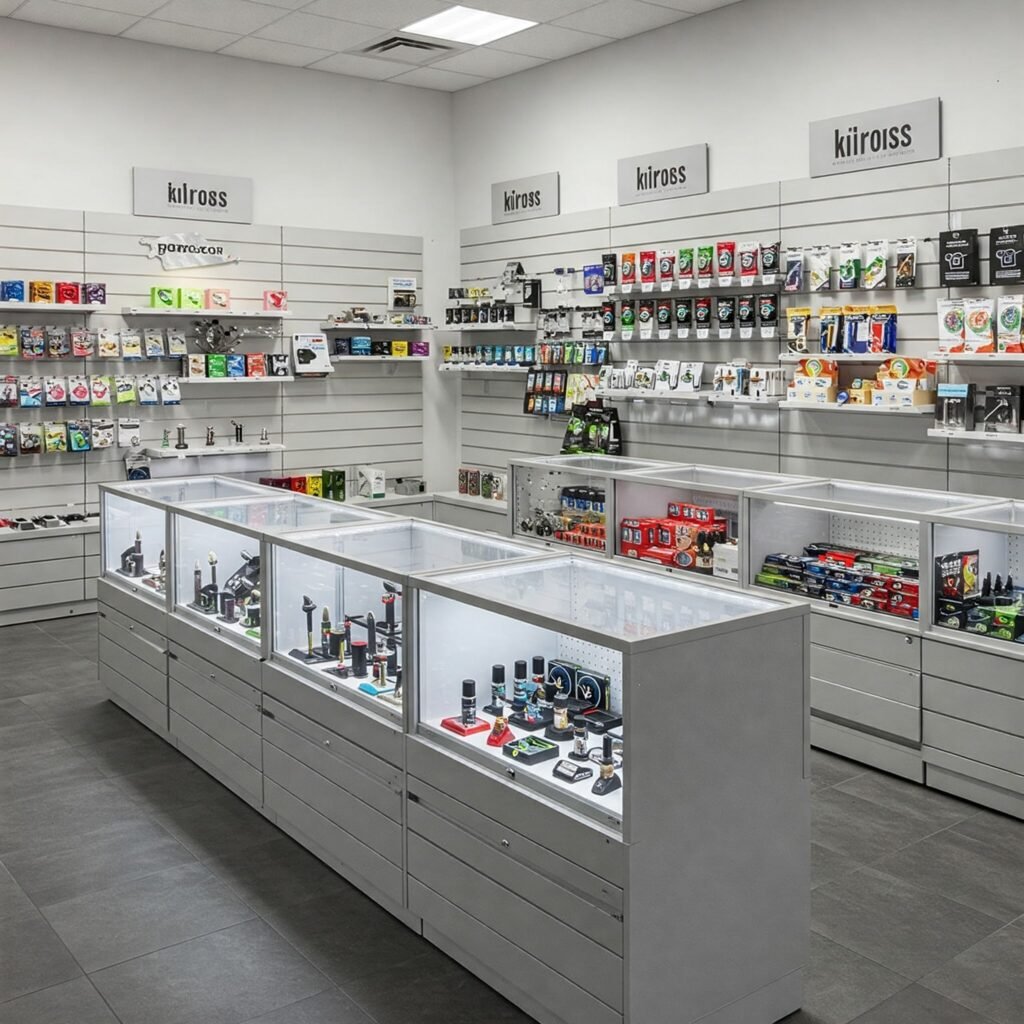
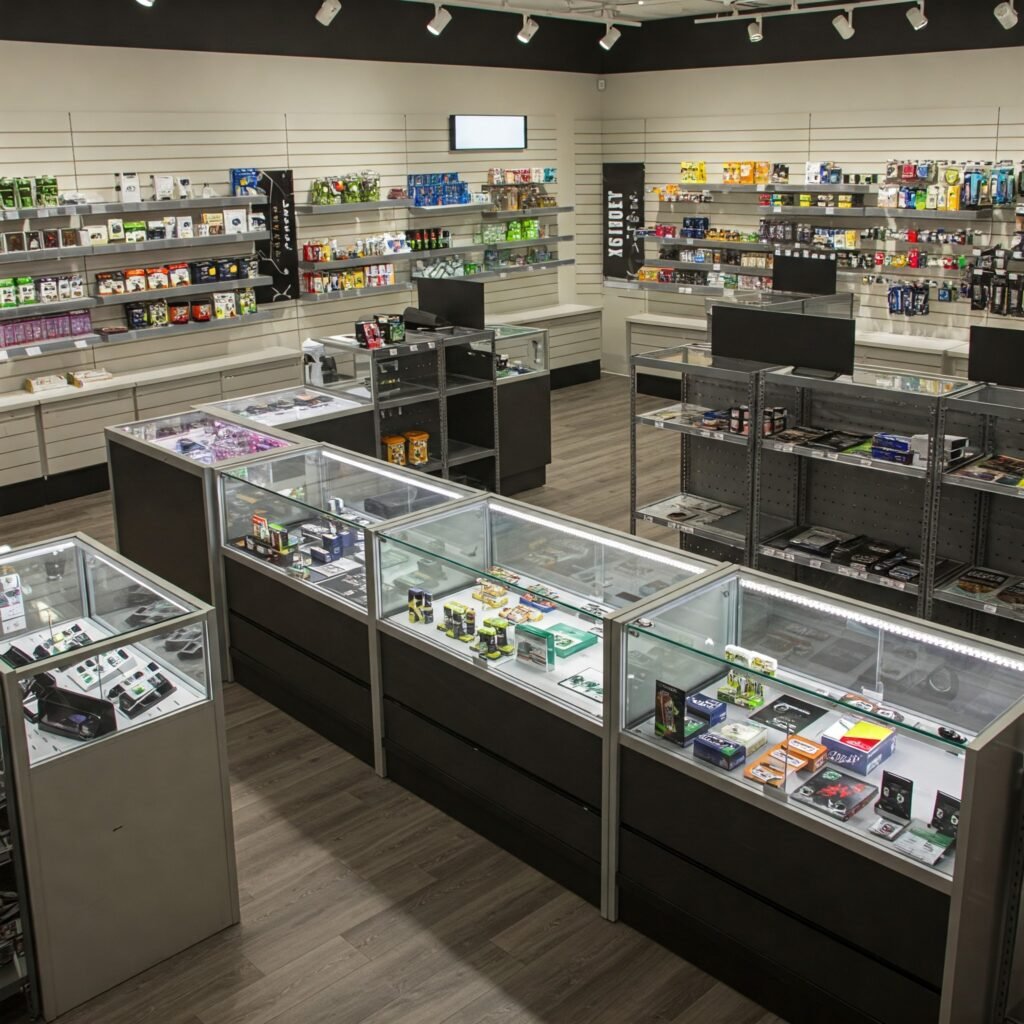
Sourcing fixtures and inventory is one of the most strategic decisions when learning how to go about starting a smoke shop or a dispensary. Quality fixtures define how products are presented. Well-selected inventory ensures customer needs are met from day one. This step affects the layout, budget, and overall brand experience. Stores that balance aesthetics and practicality attract more attention and drive better sales. Let’s explore this process in depth.
Choosing the Right Fixtures for Functionality and Branding
Prioritizing Fixtures That Match Store Design
Fixtures do more than hold products. They reflect the shop’s identity. Elegant glass showcases create a clean and high-end feel. Slatwall merchandisers add flexibility and make the store easy to update. Checkout counters guide the flow and finalize the shopping experience. Every piece must work together to create a visual theme.
A modern dispensary may prefer sleek metal finishes and neutral tones. A traditional smoke shop may include wood textures for a relaxed feel. When all fixtures share a style, the result looks intentional and professional. Matching fixtures to the brand builds trust and gives visitors a reason to stay longer.
Choosing neutral colors allows the products to stand out. Using backlighting or integrated LED strips inside glass cases can highlight high-value items. This type of focused design encourages browsing and drives impulse sales. Fixtures that look good while being easy to clean offer long-term value.
Display arrangement also influences shopping patterns. Fixtures placed along the store’s perimeter keep the middle space open. Corner units guide customers to explore. Tables and counters can draw attention to featured products. Effective layouts start with the right fixture dimensions and positions.
Ensuring Flexibility for Changing Inventory Needs
Every store changes over time. Products rotate. Trends evolve. The ability to shift displays quickly keeps the layout fresh. Fixtures with adjustable shelves or removable panels save time. Slatwall systems support multiple product types, from vape devices to hookah heads. Adding hooks, shelves, or baskets takes only minutes.
Using modular pieces allows store owners to reorganize with ease. Launching a new brand? Move the product to a central counter. Adding a clearance section? Repurpose a smaller shelf unit. Fixtures that adapt reduce long-term costs and help with seasonal promotions or vendor partnerships.
Retailers must plan for future needs. Initial displays might only use half the wall space. Planning with growth in mind ensures new inventory won’t require major renovations. Fixtures with hidden storage provide bonus value. They keep the shop tidy without taking up more floor area.
Products that change often—like disposable vapes or rolling papers—should be easy to restock. Having open-access displays for these high-turn items speeds up service and reduces clutter. Flexible fixtures support smoother workflows and faster adjustments.
Selecting Fixtures That Enhance Security
Smoke shops and dispensaries carry high-value items. Theft prevention starts with proper fixtures. Glass showcases with locks protect premium goods without hiding them. Transparent displays keep products visible while discouraging theft. This balance protects profit while maintaining appeal.
Checkout counters with built-in storage reduce the risk of misplaced items. Staff can place overstock or high-ticket items in the drawers below. Secure shelving in less accessible areas allows display without easy removal. Wall-mounted cabinets with backlit glass can house rare or featured products.
Security systems are more effective when paired with clear sightlines. Fixtures should not create blind spots. Tall units must stay close to walls. Open layouts supported by low-profile shelving allow staff to watch the floor from the counter. These details improve loss prevention and build a safer retail environment.
Lighting matters too. Well-lit displays deter theft and improve visibility on camera. Fixtures with built-in lighting increase security without requiring additional wiring. Well-planned fixture selection supports both display strategy and risk management.
Partnering with Trusted Fixture Suppliers
Working with reliable fixture suppliers simplifies the sourcing process. Vendors like Fairwill Display specialize in B2B retail fixtures. Their catalog includes glass showcases, slatwall panels, and checkout counters designed for smoke shops and dispensaries. All items are made from E1-grade board and tempered glass, ensuring safety and durability.
Clear communication with your supplier reduces errors and ensures correct dimensions. Choosing a partner with experience in this niche allows better customization. For example, a showcase may need added height for bongs or a wider counter for multiple customers. Custom requests are easier when the supplier understands the industry.
Buying directly from manufacturers cuts costs and shortens lead times. Products arrive ready to assemble, and replacements or upgrades are easier to access. Reliable partners provide installation guidance, care instructions, and after-sales support.
Over time, working with a trusted supplier builds consistency across multiple store locations. Fixtures match, even if stores open months apart. Visual unity strengthens the brand and boosts recognition. Partnering with the right supplier leads to smoother operations and long-term savings.
Building an Inventory Plan That Matches Your Market
Categorizing Product Types by Customer Preference
Inventory must match what customers want. That means studying trends and grouping products accordingly. Typical smoke shop categories include rolling papers, hookahs, pipes, vapes, and accessories. Dispensaries may carry edibles, concentrates, pre-rolls, and wellness items. Knowing how to group products helps with selection and display.
Each category should have multiple price points. Some customers want the cheapest option, while others prefer high-end pieces. Stocking a range ensures no one walks away empty-handed. Clear product segmentation makes shopping easier and improves conversion rates.
Understanding local demand sharpens category planning. In cities, disposable vape devices often sell faster than loose tobacco. In wellness-focused communities, CBD tinctures may outperform traditional smoking items. Sourcing products based on local habits prevents wasted stock and keeps shelves moving.
A successful category strategy keeps the assortment balanced. No single category should dominate unless demand clearly supports it. Creating a clean and logical breakdown makes restocking easier and boosts in-store navigation.
Selecting Suppliers with Reliable Distribution
Sourcing inventory requires trustworthy suppliers. Look for distributors with consistent delivery schedules, clear terms, and good communication. Late or missing orders cause empty shelves and lost sales. Working with vendors who specialize in smoke or cannabis products helps avoid compliance issues.
Wholesale suppliers often offer volume discounts. Leveraging those deals reduces per-unit cost. However, large orders should only be placed when confident in product demand. Storing unsold inventory ties up capital and wastes space. Flexible suppliers that allow smaller test orders add value.
Distributors with strong product knowledge provide insight into new trends. When new items gain popularity—such as heat-not-burn devices or terpene-infused rolling papers—trusted vendors often hear about it first. Staying updated through supplier networks keeps your store relevant.
Digital ordering platforms and inventory APIs can simplify the supply chain. Orders placed online with shipment tracking speed up operations. Choosing tech-savvy partners increases control and reduces delays. A modern inventory sourcing system keeps business moving smoothly.
Planning Inventory Volume for Launch
Initial stock planning must avoid overbuying. Start with smaller volumes across categories, then expand based on early sales data. Focus on high-demand staples and test specialty items gradually. For example, vapes and rolling papers sell fast almost everywhere. Rare glassware or novelty grinders might appeal to niche customers but not move quickly.
Inventory levels should also match store size. Small spaces cannot support bulk orders without looking cluttered. Staggered shelving and vertical displays help optimize small inventory layouts. Stock turnover speed should drive order volume. Fast-moving products can be restocked weekly. Slower items may be ordered monthly or quarterly.
Store owners often underestimate restocking timelines. Vendors may take days or weeks to fulfill new orders. Holding a two-week safety stock buffer reduces the risk of running out. A buffer ensures shelves stay full even when suppliers delay. Proper planning avoids gaps that hurt revenue.
Keeping digital records of launch-day sales helps identify early trends. Data on top sellers after the first month guides restocking decisions. Inventory management systems with barcode scanning reduce mistakes and simplify audits. A solid launch plan means fewer surprises and smoother operations.
Incorporating Customer Feedback into Sourcing
Once the store opens, listening to customers becomes a key sourcing tool. Customers often ask for items not yet in stock. Tracking these requests helps guide future orders. A simple feedback form or verbal log at checkout keeps this data organized.
Product suggestions highlight gaps in the current inventory. Adding items based on real demand builds loyalty and boosts repeat visits. Asking regulars what they want improves engagement and provides insights that data reports can’t offer.
Feedback also reveals underperformers. Products that never move waste valuable shelf space. Replacing them with in-demand items increases revenue per square foot. Over time, customer-driven sourcing improves both margins and satisfaction.
Offering custom orders or “coming soon” notices for requested items creates anticipation. These small efforts show that the store values its customers and adjusts accordingly. Every product request becomes an opportunity to build trust and grow the business.
Managing Inventory Flow and Store Readiness
Designing Backroom and Stockroom Systems
Storage spaces affect how efficiently the store runs. Backrooms must be organized, clean, and accessible. Inventory should be sorted by category and rotated regularly. Clear labeling avoids confusion. Overstock items should never block emergency exits or work areas.
Adjustable shelving in storage areas saves space. Bins and drawers for accessories prevent small items from being misplaced. Security features—like locked cabinets or restricted staff access—protect high-value goods. Climate control also matters. Some products degrade in heat or humidity. Proper ventilation preserves freshness and reduces damage.
Backroom design should also support incoming shipments. Designated unloading zones, check-in tables, and temporary staging areas speed up deliveries. Workflow layout affects how quickly shelves get restocked. Fast restocking reduces downtime and improves customer experience.
Efficient storage supports daily operations and seasonal promotions. Organized inventory leads to faster service and fewer lost items. Store readiness depends on a solid backroom plan.
Implementing Inventory Control Systems
Manually tracking stock leads to errors. Digital inventory systems make operations faster and more accurate. POS integration ensures sales updates sync with stock levels. Barcode scanners prevent data entry mistakes. Low-stock alerts help avoid sellouts.
Inventory control systems also identify shrinkage, theft, or miscounts. Alerts for missing items help managers investigate issues early. Reports generated from inventory tools show trends, peak times, and item turnover rates. This data supports smarter ordering and better financial planning.
Mobile apps allow real-time adjustments. Staff can update inventory during restocking or returns. Visibility across every product improves confidence in operations. Automated systems also support audit preparation. With organized records, audits become faster and less stressful.
Choosing cloud-based systems ensures access from any device. Store owners can track inventory remotely. These systems also scale easily, allowing multi-location control as the business grows. A tech-powered store runs smoother and adapts faster.
Training Staff for Inventory Handling
Employees must understand product categories, pricing, and restocking rules. Basic training in handling, labeling, and stocking helps prevent errors. Role-specific training for receiving and returns improves accountability. Assigning clear tasks keeps inventory flowing.
Visual guides, checklists, and step-by-step protocols simplify onboarding. Empowering staff with knowledge reduces mistakes and increases efficiency. Store culture built on accuracy and care supports growth.
Tracking who handles inventory tasks ensures responsibility. If errors occur, management can retrace steps. This improves overall control and protects against loss. Good training also boosts morale and confidence.
Maintaining an inventory culture from day one prevents future breakdowns. A well-trained team improves performance and reduces risk.
Preparing for Launch Day Inventory Execution
The final inventory setup before launch must be flawless. All displays must be filled, clean, and organized. Planograms guide layout. Key items should be placed at eye level. Promotional products belong near the entrance or checkout.
A dry run before opening helps test stocking efficiency. Staff rehearses pulling inventory, restocking shelves, and answering product questions. This preparation improves performance on opening day.
Inventory documentation must be finalized before sales begin. Every SKU should be logged, priced, and matched to its display. Testing barcode systems and registers before opening ensures a smooth customer experience.
A strong launch day setup creates good first impressions. Visitors expect order, clarity, and easy shopping. High standards from the start help convert first-time shoppers into regulars.
Marketing Tactics to Launch a Smoke Shop or a Dispensary


Launching a new business requires more than setting up a storefront and waiting for customers. Marketing tactics are the fuel that drives traffic, builds awareness, and creates brand loyalty. In a regulated and competitive industry, promoting your smoke shop or dispensary must be strategic, creative, and compliant. The right tactics allow stores to stand out and convert curious visitors into loyal customers. This section explores specific ways to promote effectively before and after launch.
Building Brand Identity Before Launch
Creating a Memorable Store Name and Logo
A strong brand starts with a name and logo that customers remember. These elements should reflect the store’s personality, product offerings, and customer vibe. Names that sound fresh, clean, or edgy attract younger audiences. Names with wellness or earth tones appeal to medical users or natural product fans.
Logos must be simple, scalable, and suitable for print and digital use. A busy design with too many details doesn’t scale well. Clean lines and readable text work best on signage, websites, and product labels. Vector files ensure clarity across formats.
Color schemes play a role in recognition. Warm colors suggest energy. Cool tones suggest calm. Matching colors across fixtures, walls, uniforms, and displays reinforces the brand. A strong name and logo combo helps with marketing on all levels—from business cards to online ads.
Defining Tone and Messaging Style
How a brand speaks to its customers matters. Casual, humorous tones work for vape lounges or hip smoke shops. Professional, clinical tones fit dispensaries focused on medical products. Matching the tone to the customer builds a connection.
This voice must remain consistent across platforms. Social media posts, in-store posters, websites, and employee scripts should all share the same messaging style. Consistency builds trust and improves recall. Clear messaging helps customers understand what to expect when visiting your store.
Taglines can help too. Short phrases under the logo explain what makes the shop unique. For example: “Pure Flavor. Pure Value.” or “Premium Wellness Without the Premium Price.” This quick hook strengthens first impressions and supports marketing efforts.
Creating Pre-Launch Hype With Teasers
Building excitement before launch drives attention. Teaser campaigns let people know something new is coming. Simple “coming soon” signs in the window create curiosity. Local flyers or postcards with QR codes drive people to a signup page.
Social media is ideal for countdowns, sneak peeks, or behind-the-scenes posts. A series of teaser videos or image carousels can slowly reveal products, layouts, or brand stories. Email signups allow future engagement.
Offering early access or VIP invites builds loyalty early. “Be the first to try” messaging creates urgency. Small giveaways or sneak preview events get people talking. Teaser campaigns don’t need big budgets—they need consistency and creativity.
Collecting an Email List Before the Launch
Emails remain one of the most effective ways to reach customers. Before launch, create a landing page that gathers names and addresses. Offer something in return—a discount, exclusive invite, or freebie. This builds your customer list before the first sale.
Email platforms like Mailchimp or Klaviyo help automate this process. Once people sign up, send a welcome series. Share what makes your store different. Tell your story. Show photos of the setup process. Create a human connection.
Launching with a built-in list makes day one stronger. These early subscribers are more likely to buy, review, and refer. A solid email foundation supports every campaign moving forward.
Leveraging Digital Platforms for Early Growth
Creating a Search-Optimized Website
A professional website is the digital home of your store. It needs to load fast, work on phones, and be easy to navigate. Every page should explain your products, hours, location, and contact info. A blog or news section helps with search traffic.
Using keywords like “smoke shop near [city]” or “affordable dispensary in [area]” improves search rankings. Google rewards clear, relevant content. Adding product images, store photos, and staff bios builds trust.
Online ordering systems can boost revenue. Even if local rules block direct shipping, in-store pickup tools save time. For compliance, include disclaimers and age restrictions clearly. A clean site supports every other marketing channel.
Running Google Ads to Capture Local Searchers
When people search “buy rolling papers nearby” or “where to get hookahs,” Google Ads places your store on top. These pay-per-click ads drive instant traffic. Targeting local terms ensures that only nearby users see your listing.
Budget control helps manage costs. Start with a small daily budget and adjust based on clicks. Test different headlines and ad copy. “Premium Vapes | Now Open in [City]” performs well when matched to exact location searches.
Ads that lead to a dedicated landing page improve conversions. That page should include store photos, customer reviews, directions, and a clear call to action. Pairing Google Ads with organic SEO captures both paid and unpaid traffic.
Building and Managing a Social Media Presence
Social media helps humanize your brand. Facebook, Instagram, and TikTok are key for visual storytelling. Daily posts with product images, funny memes, or educational tips build engagement. Live store tours or Q&A sessions encourage interaction.
Each platform works differently. Instagram favors high-quality photos and reels. Facebook is great for event invites and community posts. TikTok supports quick demos or skits. Use platform features—polls, hashtags, and comments—to encourage sharing.
Social media content must follow platform rules. Dispensaries in particular face ad restrictions. Focus on education and community, not direct promotion. Answer questions. Celebrate customer stories. Respond to comments quickly.
Hashtag campaigns like #SmokeSmart or #MyFirstHookah generate traction. Partnering with influencers or product reviewers expands reach. A strong social presence builds relationships and boosts brand discovery.
Encouraging Online Reviews and Testimonials
Social proof drives trust. Asking early customers to leave reviews on Google, Yelp, or Facebook improves credibility. Offer a small discount in exchange for a review. Signage near checkout reminds customers to leave feedback.
Responding to reviews builds customer relationships. Thank happy users. Address concerns with professionalism. A store with dozens of 5-star reviews attracts more new visitors than one with none.
Video testimonials are powerful too. A short clip of a customer praising service, layout, or product variety adds emotional value. Posting these on your website and social media increases impact. Over time, reviews become part of your marketing engine. They help with SEO, customer decision-making, and brand reputation.
Operating Day-to-Day

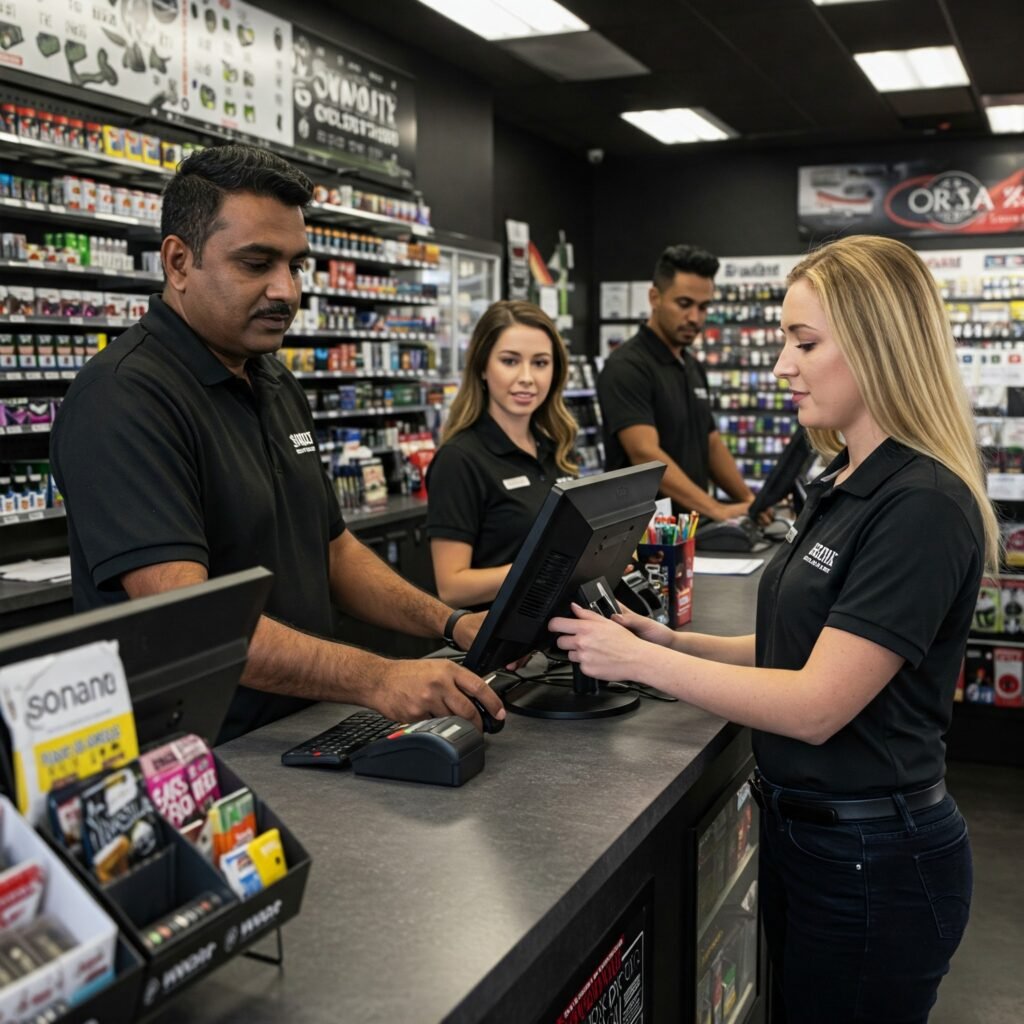
Running daily operations is where strategy becomes reality. Once the store is open, consistency matters more than grand openings or promotional buzz. Smooth day-to-day operations ensure customer satisfaction, inventory accuracy, and long-term profitability. Whether it’s a smoke shop or a dispensary, each activity inside the store must serve a clear purpose. Systems must be in place, and roles must be clearly defined. The right daily habits create efficiency and provide a better shopping experience. This section breaks down everything involved in operating day-to-day, from opening procedures to customer service protocols.
Managing Staff and In-Store Roles
Defining Clear Responsibilities for Each Position
Clarity in task division eliminates confusion and duplication. Each employee needs to know what they’re responsible for every day. For example, front-of-house staff manage customer greetings, process payments, and answer product questions. Meanwhile, stockroom employees check shipments, handle restocking, and manage inventory records. Managers supervise daily targets, monitor staff performance, and maintain compliance.
Dividing roles boosts productivity. When staff know their exact tasks, they complete them faster and more confidently. Regular checklists help track responsibilities. Morning assignments might include cleaning displays, restocking shelves, and testing the point-of-sale system. During busy hours, focus shifts to customer flow and queue handling.
Defined roles also aid in training. New employees absorb processes better when duties are clearly explained. They feel less overwhelmed and ask fewer questions once a rhythm develops. Reducing overlap also avoids employee frustration. When responsibilities are structured, accountability rises, and mistakes drop.
Training New Employees for Daily Efficiency
New hires should undergo structured training sessions before working solo. Effective training includes product knowledge, store layout, software usage, and customer interaction techniques. Hands-on simulations help prepare for real-life scenarios. Training must emphasize compliance, especially in dispensaries where legal obligations are strict.
Short refresher sessions every week reinforce procedures. This helps both new and seasoned staff stay updated with changes in inventory, pricing, or layout. When employees understand procedures deeply, their performance improves noticeably. They serve more customers in less time, and they handle unexpected issues calmly.
In smoke shops and dispensaries alike, product awareness is crucial. Employees should recognize top sellers, explain product benefits, and guide hesitant buyers. Staff who offer thoughtful recommendations elevate the shopping experience. As a result, customers spend more and return often.
Scheduling and Shift Coordination
Rotating shifts fairly ensures no employee feels overworked. Weekly schedules should account for peak hours and slower periods. High-traffic times like evenings or weekends require more coverage. Early hours may only need a skeleton crew. Using digital tools to manage scheduling prevents overlap and last-minute absences.
Shift leads or supervisors keep operations aligned. They handle escalations, monitor breaks, and ensure proper opening and closing duties are completed. Cross-training employees offers flexibility. When one team member is absent, others can fill in with minimal disruption.
Regular communication improves shift performance. Quick meetings at the start of each day can align the team. These check-ins provide updates on new arrivals, layout changes, or promotional activities. Keeping everyone informed minimizes errors and keeps energy levels high.
Maintaining Morale and Workplace Culture
A positive work environment drives higher efficiency. Recognition for performance, small incentives, and team-building moments build morale. Break areas, birthday celebrations, and flexible scheduling contribute to a balanced atmosphere.
Transparent communication encourages loyalty. Employees value workplaces where they feel heard. Open-door policies for feedback and regular reviews promote a sense of ownership. Staff who feel appreciated are more engaged, which is reflected in customer interactions.
Morale affects daily flow. Happy employees work faster, handle stress better, and support each other. When a team works well together, even the busiest days run smoothly.
Monitoring Inventory and Supply Chain
Receiving Shipments and Checking Quality
Receiving inventory begins with a thorough inspection. Every package must match the purchase order. Missing items, damaged goods, or incorrect shipments should be flagged immediately. Using barcode scanners speeds up this process and avoids manual entry mistakes.
Quality checks follow quantity verification. Packaging, product condition, and labeling must meet expectations. Damaged or questionable goods should be set aside and reported to suppliers. Accepting flawed inventory affects the store’s reputation and wastes display space.
Proper documentation ensures accountability. Receipts, invoices, and shipping logs should be filed for audits and restocking analysis. Any discrepancies need quick follow-up. Once approved, stock must be organized in the backroom or moved to display areas.
Organizing the stockroom based on product type or sales volume makes restocking easier. Fast-moving items should be placed within quick reach. Slower sellers can occupy secondary storage. Efficient receiving and inspection sets the tone for a successful retail cycle.
Keeping Track of Inventory Levels
Real-time inventory management is key to preventing stockouts or overstocking. Every item sold must be deducted from the system. Every new arrival must be added. Software integrations with the POS system help automate this tracking.
Regular audits help detect shrinkage. Discrepancies between physical and digital counts should be resolved immediately. Sometimes, items are misplaced. Other times, theft or scanning errors may be the cause. Frequent checks reduce large losses over time.
Setting par levels helps automate restocking decisions. Once a product drops below a set quantity, a re-order alert triggers. This keeps popular items available and avoids missed sales. Organizing inventory by supplier or category simplifies restocking decisions.
Inventory turnover affects profitability. Slow-moving stock takes up space and blocks cash flow. Reviewing sales data helps identify what to discount, bundle, or replace. Good inventory management ensures every square foot delivers revenue.
Rotating Stock for Fresh Displays
Products should not sit idle on shelves. Stagnant items create visual clutter and reduce appeal. Rotating stock ensures freshness and gives the display area a dynamic feel. Items that haven’t sold for weeks should be repositioned or paired with promotional signs.
Grouping similar products helps tell a story. Vaping gear beside flavored e-liquids or hookahs next to charcoal refills create logical paths. Rotating these arrangements every few weeks keeps shoppers curious and returning for new looks.
Display changeovers should occur during slow periods. This prevents disruptions and gives time for cleaning and relabeling. Rotation also helps highlight new arrivals. Clear tags or spotlight lighting can draw attention and boost first-week sales.
Smart rotation strategies extend inventory life and give older stock a second chance to move. When done consistently, they become part of the store’s routine rhythm.
Coordinating With Suppliers
Good supplier relationships support smooth operations. Clear communication ensures timely deliveries, accurate invoices, and priority during shortages. Providing regular forecasts helps suppliers plan production, reducing delays.
Setting reorder points and placing bulk orders saves time and money. Trusted vendors often offer discounts or better terms for long-term buyers. Maintaining a shared restocking calendar keeps both sides aligned.
Alternative suppliers should be on standby. If a primary vendor faces delays, secondary sources prevent gaps in inventory. Reliability ensures steady operations, especially during busy seasons.
Building partnerships with suppliers goes beyond transactions. Sharing customer feedback and market trends helps both parties grow. When vendors understand the store’s needs, they can offer better solutions and even exclusives.
Delivering Consistent Customer Service
Greeting and Engaging Shoppers
First impressions begin at the entrance. Friendly greetings build connection and comfort. Staff should acknowledge every visitor within seconds of arrival. Body language, tone, and eye contact contribute to trust.
Asking open-ended questions encourages browsing. Questions like “Looking for something new?” or “Need help choosing a flavor?” invite interaction without pressure. Helpful staff turn hesitant visitors into confident buyers.
Avoiding hard-sell tactics builds long-term loyalty. Most customers prefer space but appreciate availability. Striking that balance creates a relaxed shopping environment. Returning visitors often become regulars after a few pleasant chats.
Handling Questions and Product Education
Product knowledge builds credibility. Staff should be prepared to explain ingredients, usage, benefits, and storage tips. In dispensaries, legal requirements may include providing usage guidance or dosage details.
Training sessions help staff stay updated. Reviewing new product arrivals each week prepares the team. Printed guides or digital tablets can offer quick reference without slowing down service.
Customers appreciate informed suggestions. Guiding them to the right accessories, complementary items, or seasonal trends increases ticket size and satisfaction. Honest answers build a brand reputation over time.
Resolving Complaints and Returns
No operation runs perfectly. Handling issues with grace protects the brand. Staff should listen, empathize, and offer solutions without delay. Simple returns, exchanges, or store credits should be processed without argument.
Maintaining clear return policies prevents conflict. Displaying these policies near the counter sets expectations early. Recording issues help identify patterns. If a certain product sees frequent complaints, it might need to be dropped.
Turning a complaint into a positive moment earns trust. Customers remember how they were treated during problems more than during routine visits. Excellent problem-solving earns positive reviews and loyal fans.
Creating a Memorable Shopping Experience
Ambience matters. Clean floors, bright lighting, organized shelves, and gentle music form a welcoming atmosphere. Customers stay longer and explore more when the space feels inviting.
Promotional materials should reflect the season. Posters, product bundles, and mini-events create variety. Loyalty programs and digital coupons reward repeat visits. Sending thank-you messages or birthday discounts makes customers feel special.
Creating a space people enjoy visiting leads to higher frequency and longer stays. A memorable experience becomes the foundation of word-of-mouth referrals and five-star reviews.
Scaling Up After Starting Before Start a Smoke Shop
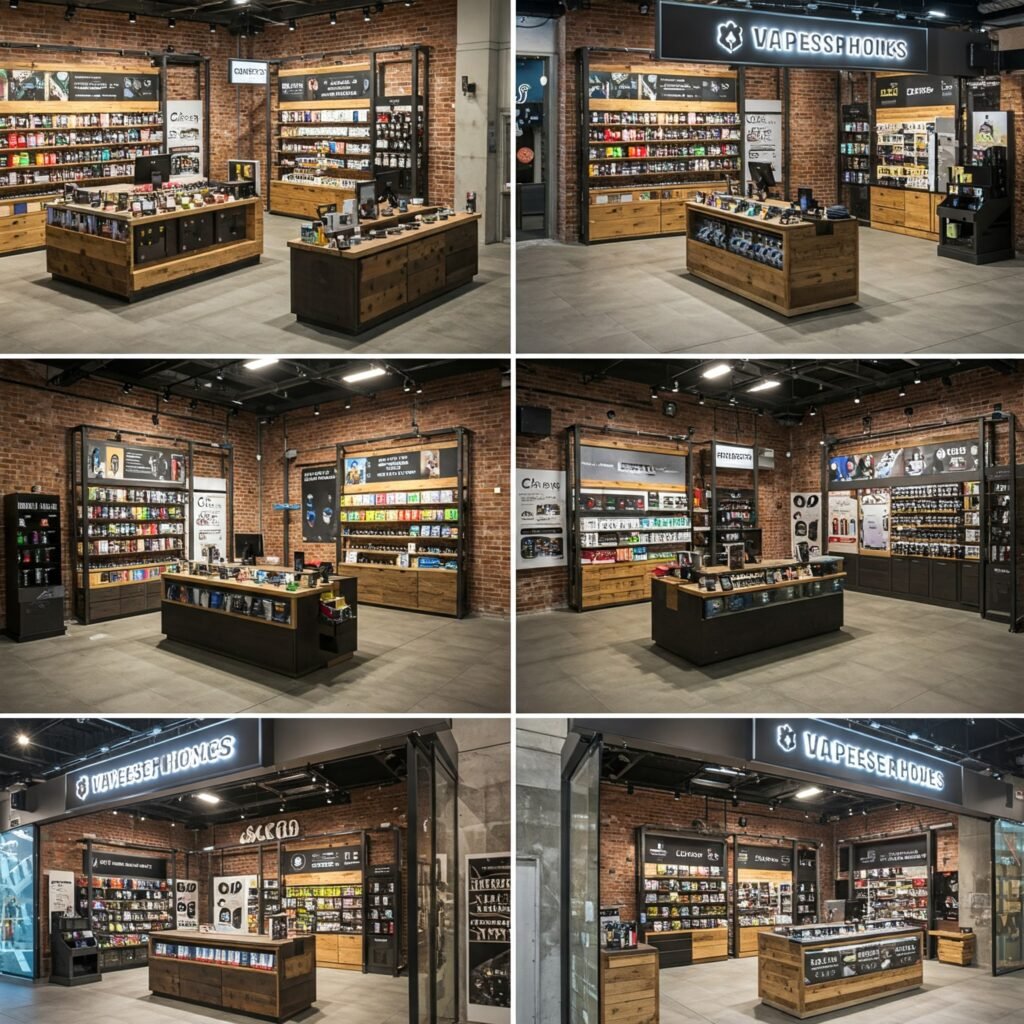
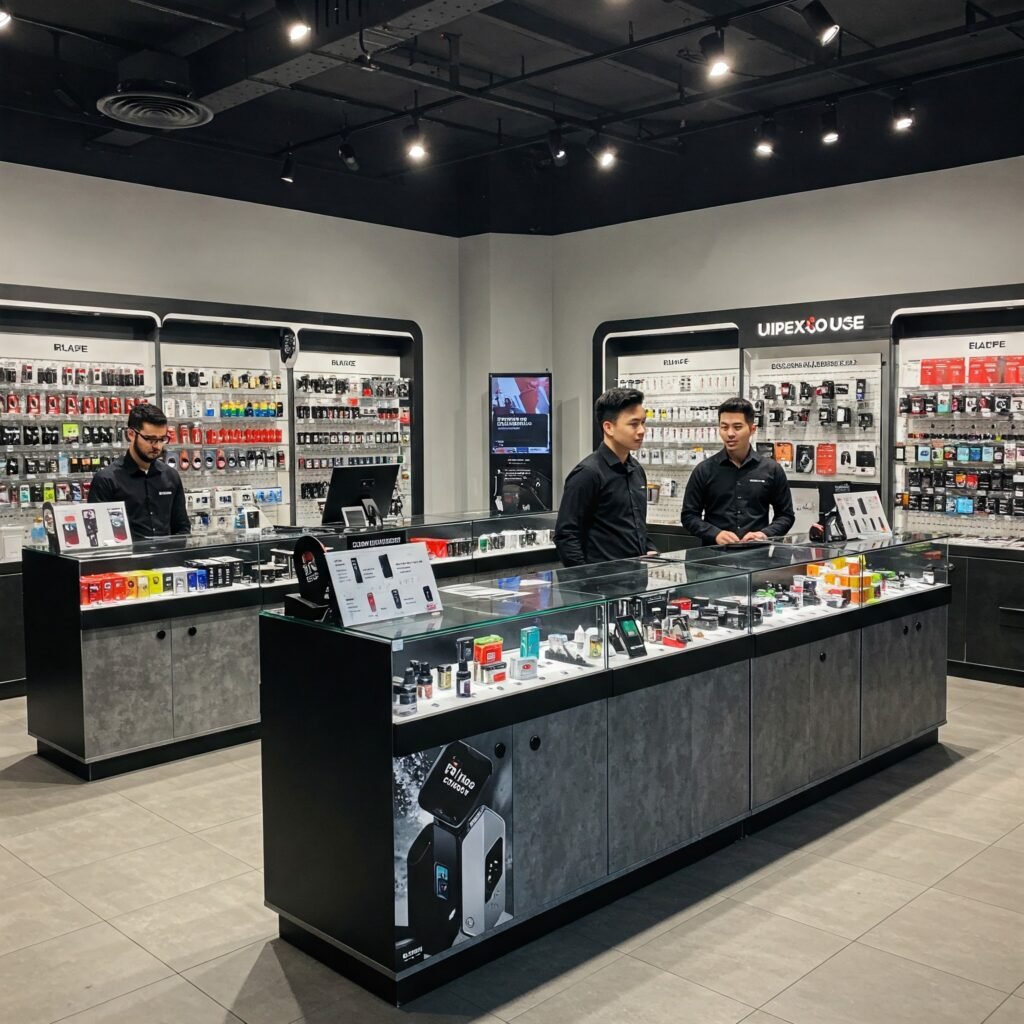
Scaling up after starting a smoke shop or a dispensary involves more than just opening additional stores. Growth should be intentional, supported by strong systems, and focused on long-term sustainability. Expansion requires careful planning, brand consistency, and solid supplier relationships. Without a solid structure, growing too quickly can lead to operational gaps, inventory shortages, and customer dissatisfaction. This section explores the key pillars of successful expansion in the smoke and dispensary retail business.
Expanding the Brand Beyond a Single Location
Replicating the Original Store’s Success
One location may do well, but expanding means proving that success can be repeated. Replicating performance across new stores starts by studying what works. Identify the layout, product mix, and marketing strategies that attracted and retained customers. Use customer feedback, sales reports, and staff input to refine these strengths.
Standardizing store designs ensures that each new location delivers the same experience. Customers recognize the brand instantly, which helps build loyalty. Using the same showcase styles, display types, and branding elements from trusted suppliers like Fairwill Display maintains visual consistency. Repeatable systems lead to scalable operations.
Hiring from within supports smooth growth. Promoting team members who understand company values leads to better results. Store managers who have experienced the launch of the first shop know how to train new employees and implement procedures correctly. Promoting internal growth builds a reliable leadership base for future branches.
Choosing New Store Locations Strategically
Launching additional stores should follow detailed analysis. Use geographic data, sales trends, and customer distribution to identify areas with strong potential. Avoid areas too close to competitors unless differentiation is strong. Aim for locations with underserved markets or growing interest in smoking accessories or cannabis products.
Expansion doesn’t have to happen only in physical stores. Online sales, delivery services, or pop-up shops can increase brand reach without the overhead of a full retail space. Testing new areas through short-term events also reveals demand before committing long-term.
Timing also plays a role. Launching too many locations too quickly can strain finances and reduce quality. Staggered openings allow teams to focus, monitor progress, and make adjustments as needed. Each new store should enhance the brand’s image and performance, not dilute it.
Maintaining Brand Identity Across Locations
Customers should experience the same feeling at every location. From the store entrance to checkout, every detail counts. Use the same colors, logo placement, and interior layout. Consistency builds trust, and trust drives loyalty.
Uniform training helps staff provide consistent service. When customers know what to expect, they are more likely to return. Creating a brand handbook ensures every team member follows the same standards. From how they greet customers to how they handle returns, clarity prevents confusion.
Visual identity also extends to signage, social media, and packaging. Using coordinated marketing materials strengthens recognition. Consistent design communicates professionalism, no matter where the customer shops.
Managing Multi-Location Operations
Managing more than one store requires systems that can handle scale. Cloud-based point-of-sale systems, inventory trackers, and team management apps reduce the risk of miscommunication. Centralized control over stock ordering prevents overbuying or running out of key items.
Each store manager should have clear responsibilities and performance goals. Routine check-ins and performance reviews help spot problems early. Data from each location should be reviewed weekly. Comparing performance helps uncover opportunities for improvement.
Having a strong supply chain is essential. Store fixtures from reliable partners like Fairwill Display should be available for every expansion phase. Establishing supplier agreements early ensures timely delivery and consistent quality. Smooth logistics make scaling feel manageable rather than chaotic.
Strengthening Inventory and Supplier Relationships
Diversifying Product Offerings
Expanding doesn’t only mean opening new stores. Growing the range of products also increases revenue. Analyze customer purchasing trends to identify bestsellers and overlooked categories. If vaping products lead in one region, explore accessories and upgrade kits. In dispensaries, introduce edibles, wellness items, or limited edition lines based on demand.
Adding seasonal promotions and limited-time offers keeps the store fresh. Introducing new items encourages repeat visits and keeps customer interest high. Bundling products help raise average transaction values without increasing prices.
New product lines require staff education. Customers ask questions and knowledgeable answers build trust. Conduct product demos, vendor-led training, or in-store tutorials. Empowered employees turn browsers into buyers.
Building Long-Term Supplier Partnerships
Reliable suppliers ensure consistent product quality and delivery schedules. Establishing strong relationships helps secure better pricing, priority access to new items, and more flexible payment terms. Choose partners who communicate clearly and meet deadlines.
Fairwill Display provides store fixtures that support brand quality. Working closely with a supplier who understands your store type simplifies reorders and layout updates. Trusted partnerships reduce stress and improve operational reliability.
Reviewing supplier performance every quarter keeps standards high. Tracking delivery times, error rates, and product quality creates accountability. Great suppliers become extensions of your team and contribute directly to customer satisfaction.
Improving Inventory Turnover and Profitability
Efficient inventory turnover reduces waste and improves cash flow. Use software to track which products move quickly and which gather dust. Rotate slow-moving items with new offers, bundle them into promotions, or mark them down to free up space.
Stocking only high-margin, fast-selling items improves shelf value. Regular audits help spot discrepancies and prevent theft. Employee training reduces shrinkage, which protects profits.
The display also affects turnover. Products placed in high-traffic areas move faster. Using lighting, signage, and proper shelf levels drives interest. Fairwill Display’s modular showcases allow for quick reconfiguration, which supports seasonal layout changes.
Scaling Inventory Systems
As store count grows, inventory becomes harder to track. Centralized systems provide real-time visibility into stock levels at each location. Shared databases reduce duplication and help redistribute inventory when needed.
Barcode scanning tools speed up counts and reduce human error. Standardizing inventory intake and display methods simplifies training and improves accuracy. Aligning all stores with the same system makes performance easier to measure.
Setting automatic reorder points prevents running out of essentials. Overstocking ties up cash, while stockouts lose sales. A balanced approach backed by data maximizes profitability.
Investing in Technology and Infrastructure
Automating Key Business Processes
Automation supports scaling by reducing manual work. Scheduling, payroll, and sales reporting can all be handled with smart tools. These systems free up time for customer service and strategic planning.
Using digital time clocks ensures accurate labor tracking. Integrated payroll systems reduce errors and keep staff paid on time. Cloud-based point-of-sale platforms track sales across all locations from a single dashboard.
Email marketing platforms can automatically send promotions or follow-ups to segmented audiences. Loyalty programs, appointment bookings, and review requests also benefit from automation.
Enhancing Customer Experience with Digital Tools
Technology improves the shopping experience. Tablets near product displays offer extra information. Self-checkout kiosks speed up busy periods. Digital menus allow for easier updates and highlight promotions.
Offering multiple payment options improves convenience. Contactless payments, mobile wallets, and loyalty card integration attract modern shoppers. Stores that embrace tech appear more professional and customer-focused.
Investing in customer feedback tools provides insight. Surveys, digital suggestion boxes, or review monitoring platforms gather useful input. Acting on feedback builds trust and loyalty.
Protecting Business with Security Solutions
As the business grows, risk management becomes essential. Installing surveillance cameras deters theft and supports incident tracking. Alarm systems protect against after-hours break-ins.
Access control systems restrict entry to sensitive areas. Cloud backups ensure data is safe from theft or system failure. Insurance policies should scale with the business. Reviewing coverage ensures protection against inventory loss, property damage, and cyber threats.
Security doesn’t only protect assets. It shows customers and employees the business takes safety seriously. A secure environment increases confidence and reduces stress for everyone involved.
Supporting Growth with Scalable Infrastructure
Infrastructure must support both current operations and future expansion. Fast internet, strong network systems, and reliable software form the backbone of multi-location retail. Systems that crash or lag harm sales and frustrate employees.
Investing in scalable platforms avoids costly replacements. Choose vendors who offer upgrade options or enterprise-level support. Long-term planning reduces disruptions and builds a resilient business.
Storing data securely and managing it properly helps with audits, reports, and performance tracking. Clean data supports better decision-making and prepares the business for long-term strategic growth.
Developing a Scalable Marketing Strategy Before Start a Smoke Shop
Centralizing Brand Messaging
Marketing a growing brand requires unified messaging. Using a consistent voice, tone, and visual identity strengthens brand recognition. Templates, guidelines, and centralized creative assets make it easier to maintain quality across platforms.
Social media, email, print, and in-store promotions should all reflect the same style. When customers see similar messages across locations and channels, brand trust increases.
Scheduling tools allow for consistent posting without manual updates. Campaign planning ahead of time supports holiday promotions, product launches, or seasonal sales. Brand-wide events help generate excitement and unify the customer base.
Tailoring Promotions to Local Markets
While the brand voice should stay consistent, promotions can be customized. Each location may serve a slightly different audience. Downtown locations may offer commuter specials. Suburban stores could run weekend family discounts. Dispensaries in medical zones may promote wellness education.
Local event sponsorships, charity drives, or neighborhood partnerships deepen community ties. A store that feels like part of the neighborhood earns loyalty faster than one that appears distant or corporate.
Collaborating with local influencers or artists personalizes outreach. Featuring local vendors in displays or offering region-specific products adds authenticity. Local focus, when combined with brand consistency, drives results.
Expanding Online Presence
Online visibility drives both digital and in-store sales. A strong website should showcase products, store locations, contact info, and customer reviews. SEO helps new customers find you through search engines.
Google My Business listings must be updated regularly. Positive reviews, photos, and location tags improve credibility and ranking. Each store location should have a page with its own hours, directions, and promotions.
Running digital ads can target specific zip codes or customer behaviors. Combining social media and paid search boosts reach. Offering in-store pickup or appointment booking connects online visibility with offline visits.
Measuring Marketing Results
Marketing without measurement wastes money. Track campaign results using KPIs such as cost-per-click, conversion rate, email open rates, and social engagement. These indicators guide future campaigns.
POS data shows which promotions increased sales. Customer surveys reveal what messages resonate. Regular reviews of performance help improve targeting, timing, and creativity.
Combining data from all locations creates a clearer picture of what works. Scaling doesn’t mean guessing—it means optimizing based on facts. Efficient marketing attracts, converts, and retains customers as the business expands.
Why Fairwill Display
Finding the right partner for store fixtures wasn’t easy. I needed someone reliable, cost-effective, and experienced in the retail industry. When I discovered Fairwill Display, everything changed. They didn’t just sell me products. They provided smart solutions, expert advice, and peace of mind. From the first conversation, I knew I was working with professionals who cared about my success.
Fairwill Display stood out for several reasons. First, their pricing made sense. As a wholesaler, I needed to manage budgets carefully. They offered competitive quotes without cutting corners. Unlike other suppliers that promised low prices but delivered poor quality, Fairwill Display gave me both affordability and durability.
But what impressed me most wasn’t just the materials or the price—it was their industry knowledge. I didn’t know which layout would maximize space. I wasn’t sure which showcase would suit my store theme. Fairwill Display offered more than options. They listened to my goals and recommended specific fixtures that matched my product type, foot traffic flow, and customer behavior. That guidance saved me time, money, and the headache of trial and error.
In the end, choosing Fairwill Display was one of the smartest decisions I’ve made as a retailer. They’re not just a supplier. They’re a long-term partner who understands the retail space, respects my budget, and supports my growth. Reach out to Fairwill Display. Let them help you turn your retail vision into a reality—just like they did for me.
